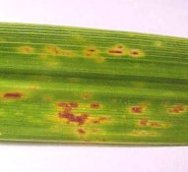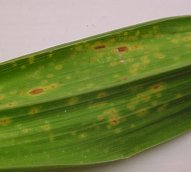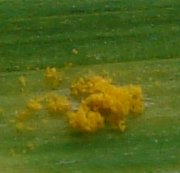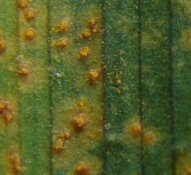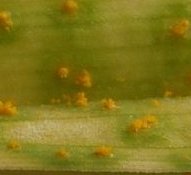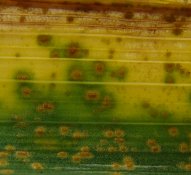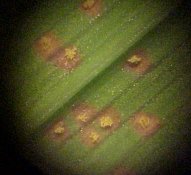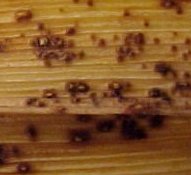Frequently Asked QuestionsQ. How many spores are produced by a single daylily rust pustule?A. The number of "summer spores" or urediniospores produced by a single daylily rust pustule ranges from 1,000 to 2,000 in 24 hours (Buck 2007). One particular daylily cultivar produced as many as 36,000 urediniospores per square cm. ten days after infection in another study (Li et al 2007). Q. How do environmental conditions affect daylily rust urediniospore germination and disease development?A. According to
research (Mueller, Buck 2003) the optimum temperature for germination
of daylily rust urediniospores ("summer spores") was determined to be 72-75°F
(22-24°C)*,
although germination also occurred at lower rates
between 45 and 93°F (7
and 34°C).
No spores germinated at 39 or 97°F
(4 or 36°C).
However, once germinated, the ability of the spores to cause an
infection at the temperatures tested was highest at 72°F
(22°C)
degrees, very low at 50°F
(10°C)
or less and also very low at 86°F
(30°C)
or higher. *Note that the temperatures in the original research article were in celsius and the fahrenheit temperatures above are rounded conversions thereof. Q. How low does the temperature have to get to kill daylily rust spores and would this prevent overwintering? A. Daylily rust urediniospores (the familiar orange "summer spores") can survive being frozen under experimental conditions at -112°F(-80°C) (Buck, Williams-Woodward 2002) therefore it isn't as simple as low temperature, unfortunately. However, while the disease is never going to experience temperatures as low as that in nature, in many areas the spores do not remain sufficiently viable under outdoor conditions to re-start infections on new daylily growth after winter (Whitten 2005, Ono 2003). The conditions that cause the spores of daylily rust to become non-viable outdoors have not been determined but may involve a combination of time, temperature, light and moisture. Even if the spores remain alive and viable they cannot infect dead plant tissue. Rust may survive winter as pre-existing infections in living foliage but not in dead leaves. It's safest to assume that any leaf area remaining alive through winter in an infected garden could potentially have living rust mycelium (fungal threads) internally that you cannot see from the outside. This mycelium is the actual "body" of the fungus and it doesn't produce visible spores immediately. The delay can be less than two weeks in ideal conditions but may extend to several weeks (Hsiang et al 2004, see also this page). Some daylilies can still have living leaves, or living parts of leaves, in the middle of a clump even when the surrounding foliage has been damaged by freezing. Spores that are released later from surviving mycelium may encounter conditions more suitable for germination and infection. In certain other plant rust diseases it has been shown that existing infections may survive the same conditions that the host's leaves can survive (Pfender and Vollmer 1999) but we do not have this information for daylily rust. In its native Asia, daylily rust would infect patrinia plants in spring, subsequently returning the rust to daylilies (Ono 2003) as discussed in detail elsewhere on this site (see the lifecycle pages). However this occurrence has yet to be reported in North America, where patrinia is not commonly grown. In North America overwintering is most likely to result from repetition of the "summer spore" cycle where it is warm enough, and/or latent internal infections. Both would require some living daylily tissue. Q. How can I tell if my daylilies have rust? A. Once you have seen rust you aren't likely to mistake it for anything else, but until then it can be confused with other daylily disorders. For example insect injuries may be invaded by fungi, the usual suspect being the leaf streak fungus, Aureobasidium microstictum. That may well be the case for the brown spots in these pictures of aphid and spider mite damage, which are definitely not rust. Note that daylily rust enters the plant through the stomata (pores) in the leaves, see the development diagram for more on this. Click on any of the images below for a larger picture.
Daylily rust is the only daylily disease that produces orange spores from spots called pustules on the leaf. Indoors, protected from rain and wind, spores can pile up as in the image below left. Outdoors you would see raised yellow-orange bumps on the leaves (and sometimes scapes) as in the right hand image below.
If a white facial tissue rubbed over the suspect leaf becomes stained with orange, then it is likely the problem is daylily rust. When scouting for daylily rust, look particularly on the undersides of the leaves. Sometimes you may see so-called "green islands" around daylily rust pustules in a dying leaf, as shown above. Brown spots with spores in their centers are more commonly noticed (see image left below) and may indicate some resistance on the part of the plant. In fall, daylily rust begins to produce dark-colored teliospores (see image on the right below). These are the "winter spores" that spend the winter on dead daylily foliage and transfer the infection to Patrinia plants in spring. Without Patrinia, these "winter spores" serve no function. See the lifecycle page for more detail.
If you're still uncertain whether your daylilies have rust, ask a daylily grower with experience of the disease or contact your local county Extension office. Q. Do you have any information on fungicides for daylily rust? A. A good article on fungicides for daylily rust was written by Patricia Crooks Henley PhD in the American Hemerocallis Society's Daylily Journal of Fall 2008, pages 40-44. This article can also be downloaded here as a PDF from the AHS's website (note that the rust survey mentioned in the article is, unfortunately, no longer available). Another useful article appeared in the Daylily Journal of Summer 2011, pages 10-12 (see also Dong et al 2013). This latter study tested fungicide dips and soil drenches as well as foliar sprays. For more fungicide articles see the Literature List page. Home gardeners often ask about teaspoon per gallon etc. amounts for fungicides and there is a link for this that may be helpful on the External Links page fungicide section. For further information on fungicides for daylily rust contact your local Extension office to find out what is currently available and recommended in your area. There is an interactive map to help you find your local Extension office here. Some Extension services have lists of homeowner fungicide products on their websites. To find these try an internet search using the keywords homeowner fungicides. References: Buck, JW and Williams-Woodward, JL. 2002. Efficacy of fungicide treatments for control of daylily rust. The Daylily Journal 57: 53-59. Buck, J. W. 2007. Potential risk of commercial geranium to infection by Puccinia pelargonii-zonalis. Online. Plant Health Progress doi:10.1094/PHP-2007-1031-02-RS. LINK , WB, ,
SN, ,
JW. 2013. Management of Daylily Rust with Different Fungicides and Application Methods.
Plant Disease Volume 97, Number 7 Pages 921-926.
ABSTRACT.
Hsiang, T., Cook, S., Zhao, Y. 2004. Studies on Biology and Control of Daylily Rust in Canada. The Daylily Journal, American Hemerocallis Society 59: 47-57. PDF REPRINT Li, YH, Windham MT, Trigiano RN , Fare DC, Spiers, JM Copes, WE 2007. Microscopic and macroscopic studies of the development of Puccinia hemerocallidis in resistant and susceptible daylily cultivars. Plant Disease. June 2007, Volume 91, Number 6 Pages 664-668 LINK Mueller, D. S. and J. W. Buck. 2003. Effects of Light, Temperature, and Leaf Wetness Duration on Daylily Rust. Plant Dis. 87:442-445 ABSTRACT.Ono, Y. 2003. Does Puccinia hemerocallidis regularly host-alternate between Hemerocallis and Patrinia in Japan? J. Gen Plant Pathol 69: 240-243. ABSTRACT. Pfender, WF and Vollmer, SS, 1999. Freezing Temperature Effect on Survival of Puccinia graminis subsp. graminicola in Festuca arundinacea and Lolium perenne. Plant Disease. Volume 83, Number 11 Pages 1058-1062. PDF Whitten, K. 2005. Foliar diseases of daylilies caused by Puccinia hemerocallidis and Aureobasidium microstictum. Thesis Master of Science, Ohio State University, Plant Pathology. LINK
©2002-2014. Susan Bergeron |
